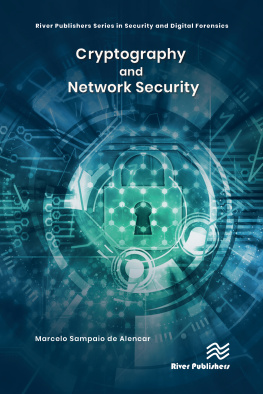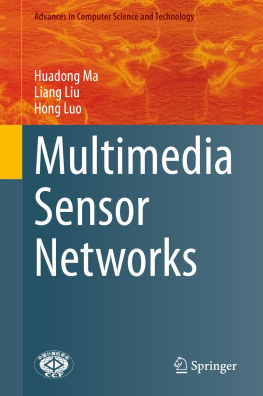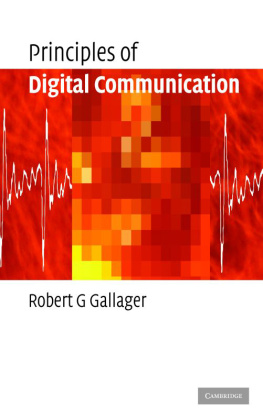First published 2020 in Great Britain and the United States by ISTE Ltd and John Wiley & Sons, Inc.
Apart from any fair dealing for the purposes of research or private study, or criticism or review, as permitted under the Copyright, Designs and Patents Act 1988, this publication may only be reproduced, stored or transmitted, in any form or by any means, with the prior permission in writing of the publishers, or in the case of reprographic reproduction in accordance with the terms and licenses issued by the CLA. Enquiries concerning reproduction outside these terms should be sent to the publishers at the undermentioned address:
John Wiley & Sons, Inc.
111 River Street
Hoboken, NJ 07030
USA
The rights of Safwan El Assad and Dominique Barba to be identified as the authors of this work have been asserted by them in accordance with the Copyright, Designs and Patents Act 1988.
Foreword
We have written this training book on digital communications in the spirit of presenting in an integrated form the basic knowledge on which modern digital communication systems are based and, above all, the way in which they are technically implemented, both in principle, and in practice. This book is the product of a long experience of training in this field in engineering school (Polytech Nantes, France).
The training is comprehensive: courses, tutorials presenting many standard problems targeted with detailed solutions, practical work concretely illustrating various aspects of the techniques of implementation.
As we have mentioned, although our experience is primarily that of training engineers, we have, through adaptations of the content, wished to address broader audiences: first in initial training, engineers, Master 2, specialized telecommunications licenses or other related specialties. But also to the trainers by providing them, through tutorials and practices (Lab Works), content that can be very useful in the construction of the training they provide. In continuing education, this book is also addressed to telecommunication technicians or for an additional year of specialization (specific years complementary to training in IUT).
This book, which is composed of two associated volumes, is presented in its first aspect, as a very concise and complete synthesis of the foundations and techniques of digital communications (Volume 1). It is broken down into two parts. The first part concerns the theory of information itself, which deals with both sources of information and communication channels, in terms of the errors they introduce in the transmission of information, as well as ways to protect the latter by using appropriate coding methods. The second part deals with the technical aspects of transmission, we first present the baseband transmission with the important concept of equalization and its implementations. The performance evaluation, in terms of probability of errors, is systematically developed and detailed as well as the on-line codes used. We then present the transmissions with digital modulation of carriers used in transmission (radio transmissions but also on electric cables).
A second important aspect, teaching knowledge and skills, composes this book (first part of Volume 2). It concerns the tutorial aspect of a course. This is an ordered set of about 30 standard problems with detailed solutions covering the different parts of the course. The set should allow a learner to gradually and deeply understand the essentials of this field and acquire the necessary skills to practice them in the industrial world.
Finally, the last aspect concerns practices in the proper sense of the term, an indispensable complement to training progressing to know-how (second part of Volume 2). We propose here a set of five lab works. The interest of these is that they go from the basic measurements on the transmission cables, to the design in software simulation of modems and cyclic coders, through the use of blocks of electronic modules carrying out basic functions useful in digital communications.
For every book sold, we will provide the buyer with two practical pieces of software from MATLAB-Simulink: Modem QPSK and Cyclic encoderdecoder, free of charge. We will provide necessary explanations and endeavor to help with the set-up of the two pieces of practical material.
Part 1
Theory of Information
Introduction to Part 1
Transmitting information between two entities, commonly referred to as the source of information for the first and the recipient or user for the second, assumes that this information is represented in a common and understandable form by both parties. It is also necessary that the amount of information exchanged does not exceed the transmission capacity of the channel. Lastly, it is desirable that the disturbances (modifications of all kinds) in the transmission channel have, if possible, little or, ideally, no effect on the information delivered to the recipient or user.
All this is studied, analyzed and treated in what is called the theory of information, the theoretical basis of different techniques of communication.
In a schematic way, the problems raised and treated by this are the following:
- quantitative measurement of information;
- representation of common information between sender and recipient: code;
- source coding: adapting the source rate to the capacity of the transmission channel;
- channel coding: protecting against transmission errors.
The block diagram of shows at what levels of the communications chain these problems are, both on the side of the emission of the information (transmitter) as on the side of the reception of the information (receiver).

We have divided this first part, dedicated to the theory of information, into three chapters following a first chapter of general introduction to telecommunications (). Each of these three chapters is devoted to each of the three issues raised previously:
- measurement of information ();
- source coding for the transmission on channels without disturbances ();
- channel coding for transmission on channels with disturbances ().
Introduction to Telecommunications
1.1. Role of a communication system
A communication system aims to convey as faithful and reliable messages as possible between a sender and a recipient, at any distance, with reasonable costs. Messages are information entities and their routing requires the existence of a communication channel to convey them ().

The particular features of a communication system are described below:














